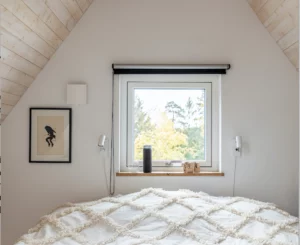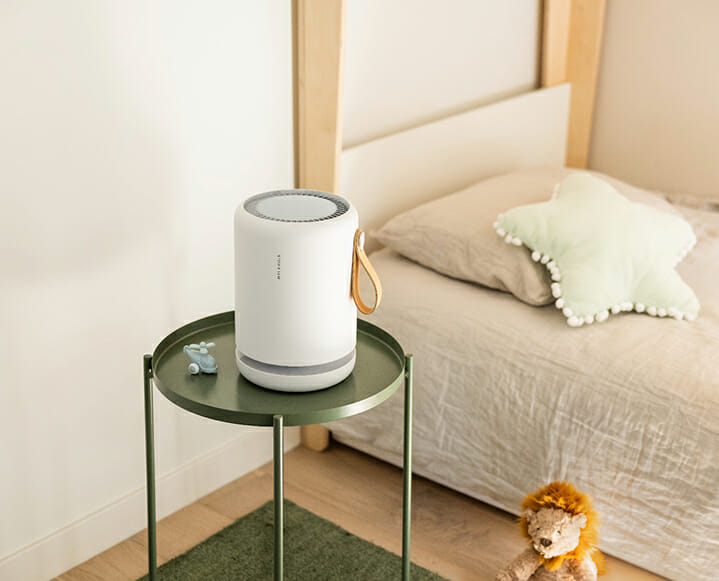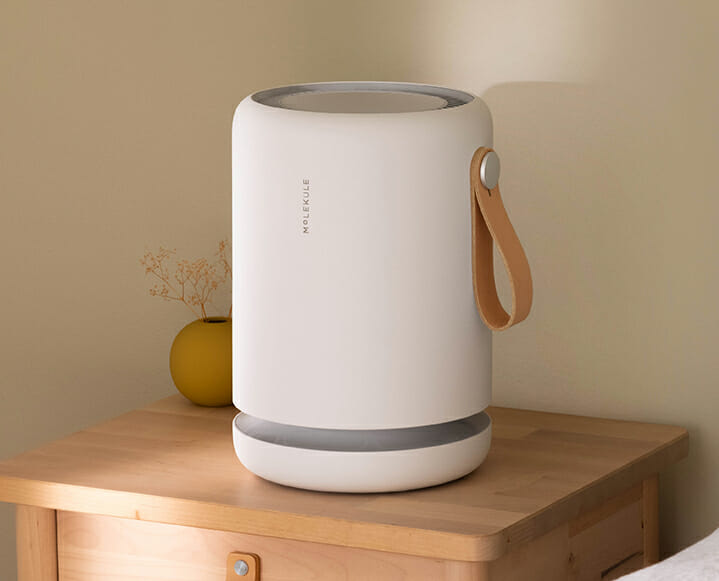
Everything in our environment plays an important role in the quality of our health and wellbeing. While you may make a conscious choice to eat healthy organic food, drink filtered water, exercise regularly, and use natural skin care products, it’s just as essential to consider the quality of the air you breathe.
Although we can’t see them, most of us are inhaling countless airborne toxins every day. This is the reality of modern life, especially if you live in a city. And it’s a critical health and wellness concern. These toxins are in the air around you, and while they are often outside of our control—for example, pollution in urban areas from manufacturing, vehicles, and wildfire smoke (us West Coasters are unfortunately all too familiar with this)—many of actually originate from within our homes.
Sources of indoor air pollution include smoke from stoves, fireplaces, and synthetic fragranced candles, mold, paint fumes, off-gassing from furniture and upholstery, plus allergens that accumulate from the outdoors, such as dust and pollen, as well as pet dander. If you have little ones at home, are pregnant, or are breastfeeding, pay extra attention to the quality of your indoor air, as young respiratory systems are more sensitive to irritants and pollutants.
Even if you keep a non-toxic home, you might be surprised by these hidden sources of air pollution:
+ Toxic Dust Polybrominated diphenyl ethers (PBDEs) — These are substances used in fire retardant chemicals. They are a known nervous system toxin which can accumulate in your home (and body), stressing the liver and kidneys while diminishing brain function and behavior. PBDEs are currently used in plastics and fabrics (including clothing), most notably in electronic devices accumulating in that ever pervasive media center dust. Cleaning and clearing this toxic dust out of your home and workspace is especially important for pregnant women and breastfeeding mothers, as infant exposure to PBDEs through mother’s milk can reach concerning levels.
+ Volatile organic compounds (VOCS) — Cleaning products are some of the most common and most toxic culprits of indoor air pollution. They often contain bleach, ammonia, and VOCs, which are released into the air. You can end up inhaling them long after they are used. These substances can cause eye irritation, headaches, itchiness, sore throat, respiratory distress, and can disrupt your hormone balance, which can contribute to a host of systemic health concerns.
+ VOC’s during home renovations — A wide range of products used during home renovations—including paints, caulks, carpeting, sealants and adhesives—emit VOCs that can be harmful to your health. Additionally, most types of home improvement projects can stir up particulate matter that pollutes your indoor air.
+ Mold — Excessive mold can have a big impact on indoor air quality and your health and wellbeing. The CDC warns that indoor mold exposure has been linked to coughing, wheezing and other respiratory symptoms. If you live in an old home, by the beach, or have had leaks or water damage, be sure to check your home for mold accumulation. While some household mold is inevitable, it’s important to keep an eye on areas of concern and have your house checked, if you’re unsure. Though an air purifier cannot help you clean up the mold, it can help remove any mold spores that have been released into the air.
+ Smoke from incense — This can include sweetgrass, sage, palo santo...the list goes on. A 2002 study found that incense smoke can contain concentrations of harmful gasses and particulate matter that are high enough to cause adverse health effects (Jetter, et. al, 2002). If avoiding incense altogether is not an option for you, an air purifier can be a helpful tool to improve indoor air quality.
7 Supports And Solutions For Improving Indoor Air Quality
1. Invest in 1-2 high quality air purifiers for your home. Molekule is a top of the line option that removes toxic particles from the air. Unlike other air purifiers, Molekule takes fresh air to a whole new level. It doesn’t just re-circulate air but actually destroys pollutants such as mold, VOCs, and allergens—things that can burden your health, including your breathing and sleep quality. As you know, breathing well and getting good sleep are absolute essentials for optimal vitality.
If you or your family suffer from respiratory issues or allergies, Molekule air purifiers are a supportive option. They work by pulling pollutants and allergens out of the air, thereby reducing your exposure and helping to alleviate symptoms. The Air Mini+ model is a wonderful option for children’s rooms, play spaces, offices, and any small living space.
2. Use proper ventilation + air circulation when cooking and cleaning. These household activities are often overlooked as a source of indoor air pollution, but they can release a lot of smoke and fumes into the air that can degrade air quality and affect your health. Make sure you run your air filters afterwards to help clear away any lingering residue.
3. Opt for organic + natural cleaners. There are so many products on the market now that make it easy to find natural + organic options that work effectively. Skip air fresheners and other synthetically fragranced products, and use natural beeswax candles. The Environmental Working Group is a fantastic resource for gaging the integrity and quality of your products. Research products before you shop.
4. Invest in some houseplants. Plants purify the air by absorbing carbon dioxide and releasing clean oxygen for you to breathe. Bonus: They liven up any space and bring beauty into your home.
5. Clean + dust regularly. This is important no matter where you live, but especially if you’re in a big city like L.A. or N.Y. where dust and pollutants accumulate rapidly. Run your air filter while vacuuming + post cleaning and dusting as particles can linger in the air for hours.
6. Test the air in your home. If you’re concerned about mold, possible gas leaks and overall air quality, hire an environmental + air remediation service to evaluate your home and recommend a course of action to improve your air quality.
7. Breathe deeply. Once you’ve addressed the air quality in your home by implementing the above tips, take a deep breath and chill. Deep breathing is essential for supporting your mental and physical health. Intentionally taking the time to slow down, drop into your body and breath brings your nervous system into the parasympathetic state, which brings a sense of calm and relaxation to your entire being. It’s something we could all use a little more of these days. When you know you’re breathing in clean air, it makes this practice all the more soothing and restorative.
When it comes to your current and long-term health it’s imperative that you address every facet of your internal and external environment. The quality of the air you breathe matters. A lot. After all, air is the very breath of life.
If you live in a city an air purifier is nearly a non-negotiable. It’s an investment that can pay off by helping to relieve your symptoms in the short-term and can help prevent the worsening of health concerns in the long-term.
Developed over 25 years by research scientists, Molekule air purifiers are ideal for any room, whether it’s a home, office, or commercial setting. Their innovative PECO-filter technology uses a proprietary catalyst to safely destroy a vast range of indoor air pollutants at a molecular level, including viruses, bacteria, mold, ozone, allergens, and chemicals found in smoke. Molekule air purifiers are effective against air-borne pollutants 1000 times smaller than those used in tests to qualify filters as HEPA.
New research shows Molekule Air Mini removed 99.98% of the SARS-CoV-2 virus from the air in a one-time release multiple pass test in a small chamber, PECO destroyed over 99% in a filter swatch level test in under one hour.* These results build on past research with viral capture and destruction and demonstrate how PECO adds a layer of protection against airborne viruses.
The post The Wellness Issue We Don’t Talk About: Dealing with Air Pollution At Home appeared first on The Chalkboard.
from The Chalkboard https://ift.tt/2mbwTLJ
via IFTTT
No comments:
Post a Comment